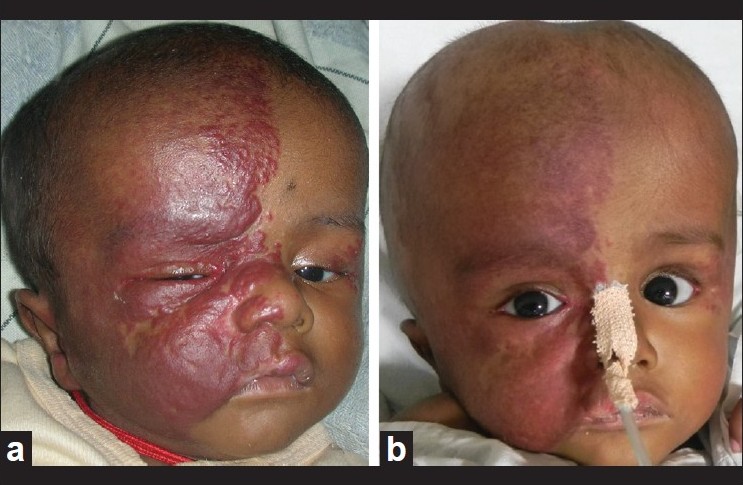Translate this page into:
Excellent response of infantile hemangioma associated with PHACES syndrome to propranolol
Correspondence Address:
Devinder Mohan Thappa
Dermatology and STD Department, Jawaharlal Institute of Postgraduate Medical Education and Research (JIPMER), Pondicherry - 605 006
India
| How to cite this article: Mohanan S, Besra L, Chandrashekar L, Thappa DM. Excellent response of infantile hemangioma associated with PHACES syndrome to propranolol. Indian J Dermatol Venereol Leprol 2012;78:114-115 |
Sir,
Facial segmental infantile hemangiomas are said to be associated with PHACES, a neurocutaneous syndrome comprising of Posterior fossa brain malformations, cervicofacial segmental Hemangiomas, Arterial anomalies, cardiac defects or coarctation of aorta, eye anomalies and sternal defects such as sternal clefting or supraumbilical raphe. [1] Herewith, we report a 2.5-month-old male infant with PHACES syndrome with good response of the hemangioma to treatment with propranolol.
A 2.5-month-old male infant was brought to us with a large red-colored lesion on the right side of the face and scalp from birth. He was a term baby born of a non-consanguineous marriage with assisted vaginal delivery having a birth weight of 3 kg and normal APGAR score. On physical examination, the child was active and feeding well. The head circumference was 43 cm as against the expected 38 cm at 2 months of age. There was no neurological deficit. The child had a large segmental infantile hemangioma extending over the right side of the face measuring 14 cm x 7 cm in the maximum diameter. He also had a small hemangioma on the left eyelid [Figure - 1]a. His hemogram showed a normal profile with normal platelet count. Thyroid function tests were within normal limits. Computerized axial tomography and magnetic resonance imaging of the brain revealed a cyst in the posterior fossa communicating with the fourth ventricle resulting in hydrocephalus [Figure - 2]. Echocardiograpy of the heart revealed a small patent ductus arteriosus (PDA). Eye, ear, nose and throat examination did not reveal any abnormalities.
 |
| Figure 1: (a) Large segmental infantile hemangioma involving the right side of the face and forehead. (b) Significant regression in the size of the hemangioma following administration of propranolol after 4 months |
 |
| Figure 2: Computerized tomography of the brain revealing a posterior fossa cyst communicating with the fourth ventricle and dilated lateral ventricles |
The infant was put on low-dose propranolol (0.17 mg/kg per dose three times daily) under careful monitoring of heart rate and blood glucose levels. The dose was gradually increased over 3 days to 2 mg/kg/ day. The child was discharged and propranolol was continued for 4 months with significant regression of the hemangioma [Figure - 1]b. Following this, surgery to correct the Dandy-Walker malformation was planned by neurosurgery, during the course of which propranolol was stopped. There was no rebound flare in the size of the plaques.
It has been estimated that 2% of all patients with hemangiomas meet the diagnostic criteria for PHACES syndrome. [2] Diagnostic criteria include the presence of hemangiomas and at least one of the extracutaneous anomalies described. Modified criteria have been proposed for definitive and possible diagnosis of PHACES syndrome. [3] Our patient had cervicofacial hemangiomas with Dandy-Walker malformation, hydrocephalus and a small PDA.
Treatment of hemangiomas of PHACES syndrome is similar to that of infantile hemangiomas. Patients have been treated with oral steroids, intralesional steroids, vincristine, interferon-α and pulse-dye laser. [2] Surgical repair has been advocated for the aortic arch anomalies after comprehensive assessment of the vasculature. [4] We considered propranolol in this patient in order to avoid the long-term complications of systemic steroids. Our patient was started on propranolol after careful work-up, monitored for side-effects and maintained on propranolol until surgery with good response. Problems commonly anticipated with propranolol are bradycardia and hypoglycemia. In the setting of PHACES, propranolol can mask signs of heart failure, worsen cardiac function or induce hypotension leading to a theoretical risk of brain infarcts in patients with anomalous cerebral vasculature. [5] There have been few recent reports of safe use of propranolol in the setting of PHACES. [6],[7] We report this case to highlight the fact that propranolol can be used in the setting of PHACES under careful monitoring.
| 1. |
Miller T, Frieden IJ. Vascular tumours. In: Wolff K, Goldsmith LA, Katz SI, Gilchrest BA, Paller AS, Leffel DJ, editors. Fitzpatrick's Dermatology in General Medicine.7 th ed. New York: McGraw- Hill; 2008. p. 1164-72
th ed. New York: McGraw- Hill; 2008. p. 1164-72'>[Google Scholar]
|
| 2. |
Mussa A, Baldassarre G, Rosaia De Santis L, Gastaldi R, Corrias A, Silengo MC. Four new cases of PHACES syndrome: Variable phenotypic expression and endocrine features. Acta Paediatr 2008;97:1729-33.
[Google Scholar]
|
| 3. |
Metry D, Heyer G, Hess C, Garzon M, Haggstrom A, Frommelt P, et al. Consensus statement on diagnostic criteria for PHACE syndrome. Paediatrics 2009;124:1447-56.
[Google Scholar]
|
| 4. |
Giardini A, Gholam C, Khambadkone S, Kostolny M. Need for comprehensive vascular assessment before surgical repair of aortic coarctation in PHACES syndrome. Pediatr Cardiol 2010;31:291-3.
[Google Scholar]
|
| 5. |
Lawley LP, Siegfried E, Todd JL. Propranolol treatment for hemangioma of infancy: Risks and recommendations. Pediatr Dermatol 2009;26:610-4
[Google Scholar]
|
| 6. |
Vasaiwala R, Sajja K, Setabutr P. Novel management of the microphthalmic orbit in a patient with PHACE syndrome. Ophthal Plast Reconstr Surg 2011 [In Press].
[Google Scholar]
|
| 7. |
de Graaf M, Breur JM, Raphaël MF, Vos M, Breugem CC, Pasmans SG. Adverse effectsth of propranolol when used in the treatment of hemangiomas: A case series of 28 infants. J Am Acad Dermatol 2011;65:320-7.
[Google Scholar]
|
Fulltext Views
2,637
PDF downloads
1,121





